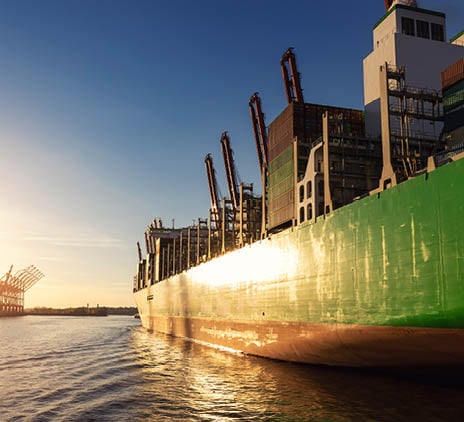-
Financial administration & outsourcing
Entrepreneurs who outsource financial administration reduce the number of administrative tasks and consequently have more time and space to focus on growth.
-
Financial insight
We help you turn financial data into valuable insights that support you in making well-founded decisions. In-depth analyses of your financial situation will help give you a better idea of where you stand and where the opportunities for growth lie, both in the short and long term.
-
Financial compliance
We make sure your company complies with financial legislation and regulations, with correct financial statements, tax reports and other obligations. From our global network, we support you in managing local and international tax risks.

-
Impact House by Grant Thornton
Building sustainability and social impact. That sounds good. But how do you go about it in the complex world of stakeholders, regulations and frameworks and changing demands from clients and society? How do you deal with important issues such as climate change and biodiversity loss?
-
Business risk services
Minimize risk, maximize predictability, and execution Good insights help you look further ahead and adapt faster. Whether you require outsourced or co-procured internal audit services and expertise to address a specific technology, cyber or regulatory challenge, we provide a turnkey and reliable solution.
-
Cyber risk services
What should I be doing first if my data has been kidnapped? Have I taken the right precautions for protecting my data or am I putting too much effort into just one of the risks? And how do I quickly detect intruders on my network? Good questions! We help you to answer these questions.
-
Deal advisory
What will the net proceeds be after the sale? How do I optimise the selling price of my business or the price of one of my business activities?
-
Forensic & integrity services
Do you require a fact finding investigation to help assess irregularities? Is it necessary to ascertain facts for litigation purposes?
-
Valuations
Independent and objective valuations tailored for mergers, acquisitions, and legal matters.

-
Auditing of annual accounts
You are answerable to others, such as shareholders and other stakeholders, with regard to your financial affairs. Financial information must therefore be reliable. What is more, you want to know how far you are progressing towards achieving your goals and what risks may apply.
-
IFRS services
Financial reporting in accordance with IFRS is a complex matter. Nowadays, an increasing number of international companies are becoming aware of the rules. But how do you apply them in practice?
-
ISAE & SOC Reporting
Our ISAE & SOC Reporting services provide independent and objective reports on the design, implementation and operational effectiveness of controls at service organizations.

-
International corporate tax
The Netherlands’ tax regime is highly dynamic. Rules and the administrative courts raise new challenges in fiscal considerations on a nearly daily basis, both nationally and internationally.
-
VAT advice
VAT is an exceptionally thorny issue, especially in major national and international activities. Filing cross-border returns, registering or making payments requires specialised knowledge. It is crucial to keep that knowledge up-to-date in order to respond to the dynamics of national and international legislation and regulation.
-
Customs
Importing/exporting goods to or from the European Union involves navigating complicated customs formalities. Failure to comply with these requirements usually results in delays. In addition, an excessively high rate of taxation or customs valuation for imports can cost you money.
-
Human Capital Services
Do your employees determine the success and growth of your organisation? And are you in need of specialists which you can ask your Human Resources (HR) related questions? Human Resources (HR) related questions? Our HR specialists will assist you in the areas of personnel and payroll administration, labour law and taxation relating to your personnel. We provide you with high-quality personnel and payroll administration, good HR guidance and the right (international) advice as standard. All this, of course, with a focus on the human dimension.
-
Innovation & grants
Anyone who runs their own business sets themselves apart from the rest. Anyone who dares stick their neck out distinguishes themselves even more. That can be rather lucrative.
-
Tax technology
Driven by tax technology, we help you with your (most important) tax risks. Identify and manage your risks and become in control!
-
Transfer pricing
The increased attention for transfer pricing places greater demands on the internal organisation and on reporting.
-
Sustainable tax
In this rapidly changing world, it is increasingly important to consider environmental impact (in accordance with ESG), instead of limiting considerations to financial incentives. Multinational companies should review and potentially reconsider their tax strategy due to the constantly evolving social standards
-
Pillar Two
On 1 January 2024 the European Union will introduce a new tax law named “Pillar Two”. These new regulations will be applicable to groups with a turnover of more than EUR 750 million.
-
Cryptocurrency and digital assets
In the past decade, the utilization of blockchain and its adoption of a distributed ledger have proven their capacity to revolutionize the financial sector, inspiring numerous initiatives from businesses and entrepreneurs.
-
Streamlined Global Compliance
Large corporations with a presence in multiple jurisdictions face a number of compliance challenges. Not least of these are the varied and complex reporting and compliance requirements imposed by different countries. To overcome these challenges, Grant Thornton provides a solution to streamline the global compliance process by centralizing the delivery approach.
-
Corporate Law
From the general terms and conditions to the legal strategy, these matters need to be watertight. This provides assurance, and therefore peace of mind and room for growth. We will be pro-active and pragmatic in thinking along with you. We always like to look ahead and go the extra mile.
-
Employment Law
What obligations do you have with an employee on sick leave? How do you go about a reorganisation? As an entrepreneur, you want clear answers and practical solutions to your employment law questions. At Grant Thornton, we are there for you with clear advice, from contracts and terms of employment to complex matters such as dismissal or reorganisation.
-
Sustainable legal
At Grant Thornton, we help companies integrate sustainability into their business operations, with sustainable legal at the heart of our approach. We advise on ESG (Environmental, Social, Governance) legislation, and help draft sustainable contracts, implement HR policies, and carry out ESG due diligence in M&A transactions (Mergers and Acquisitions).
-
Maritime sector
How can you continue to be a global leader? The Netherlands depends on innovation. It is our high-quality knowledge which leads the maritime sector to be of world class.


What is considered forced labour?
According to the International Labour Organization (ILO), forced labour is defined as “all work or service extracted from any person under the menace of penalty and for which the person has not offered himself voluntarily.” This can involve coercion through threats, violence, debt bondage, withholding identity documents, or other forms of exploitation.
In other words:
“Forced labour involves any work or service that a person is compelled to perform against their will, typically under threat of punishment or harm”
As forced labour concerns continue rising, businesses face increasing pressure from regulators, investors, and the public to carefully review their supply chains and address these practices. An example of this is the EU Forced Labour Regulation (EUFLR).
What is the EU Forced Labour Regulation (EUFLR)?
Formally adopted by the EU Council in December 2024, the EU Forced Labour Regulation aims to ban the import, sale, and export of products made with forced labour. The EUFLR requires and encourages the prevention of forced labour (including child labour) in all stages of a product’s life cycle, including and not limited to:
- Production, manufacturing, harvesting, or processing
- Both EU-produced and non-EU produced goods
- Online or distance sales (covering modern retail channels)
Notably, the EUFLR:
- Prohibits products suspected of having been made using forced labour from entering or circulating within the EU market
- Empowers national authorities to investigate and take enforcement actions, such as bans and withdrawals (not yet known which authority this will be in most countries)
- Explicitly excludes transport services, keeping its focus on products and their components
The link between EUFLR, the CSDDD, and other regulations
The EUFLR builds upon the EU’s broader legislative efforts to enhance supply chain transparency, promote responsible business conduct, and uphold human rights. This collection of initiatives includes the Corporate Sustainability Due Diligence Directive (CSDDD), which requires companies to establish and maintain robust due diligence measures to safeguard human rights, as well as the EU Deforestation Regulation (EUDR), which aims to prevent the placement of products linked to deforestation and forest degradation on the EU market.
Unlike more targeted legislation, such as the EUDR, the EUFLR adopts a global and far-reaching approach by banning all products linked to forced labour—regardless of industry or geographical origin—from being placed on, sold in, or exported from the EU market.
While the EUFLR itself does not create entirely new due diligence obligations, it emphasizes the critical need for solid, existing frameworks and processes around human rights due diligence to ensure compliance.
In other words:
“Having proper value chain due diligence practices in place that follow OECD requirements will form a solid basis for complying with EUFLR and would be the recommended first step in preparing for EUFLR”
Which companies fall under the EUFLR and when?
The EUFLR applies to all companies (referred to as “economic operators”), irrespective of:
- Size – from large multinationals to micro; small; and medium-sized economic operators
- Sector – manufacturing; retail; services; etc.
- Location – operating within or outside the EU
As long as a company places products on the EU market or exports products from the EU, it falls under the regulation. This also includes goods sold through distance sales (e.g, online platforms).
It is good to note that the European Commission will issue guidelines on due diligence in relation to detecting and preventing forced labour, which should also take into account the size and economic resources of economic operators
Definition of ‘economic operator’: any natural or legal person or association of persons placing or making available products on the Union market or exporting products.
The requirements
While the EUFLR does not impose additional standalone due diligence obligations on companies, it complements existing due diligence requirements that (amongst others) the CSRD and the CSDDD also refer to: ILO Forced Labour Conventions; UN Guiding Principles on Business and Human Rights; OECD Guidelines for Multinational Enterprises and the OECD Due Diligence Guidelines.
Roles/Obligations under the EUFLR:
- European Commission: Will publish implementation guidelines and maintain a forced labour risk database.
- National Authorities: Responsible for investigating and enforcing bans on products suspected to be made with forced labour.
- Companies: Expected to have suitable policies and systems in place to identify, prevent, mitigate, and eliminate forced labour, including child labour, in their supply chains.
Non-Compliance Consequences
Investigations into suspected non-compliance can be initiated by national authorities or the EU Commission. The process typically involves:
- Initial Request: Companies are asked to provide evidence of due diligence measures within 30 days.
- In-Depth Investigation: If insufficient, further evidence must be supplied within 2 months.
Possible Sanctions:
- Product Bans: Removal of non-compliant products from the EU market.
- Withdrawals & Disposal: Compulsory disposal of goods found to be in violation.
- Fines & Restricted Market Access: Financial and operational penalties.
How we can help
We help our clients to turn topics such as the EUFLR from a regulatory burden into an opportunity for businesses to enhance their social impact and supply chain resilience. Here’s what we offer:
Timeline
By proactively implementing robust due diligence measures, your organisation can stay ahead of the EU Forced Labour Regulation, and also lay the groundwork for compliance with related legislation such as the CSRD and CSDDD.Grant Thornton stands ready to help you navigate this evolving landscape, aligning compliance goals with broader business objectives and societal impact.
Would you like more information?
Please contact one of our experts. They are here to help you out.












